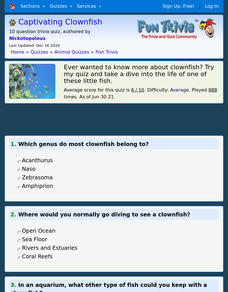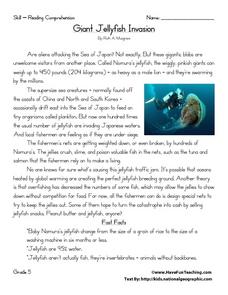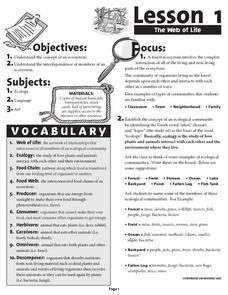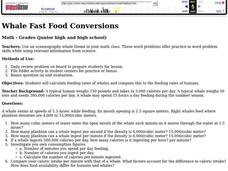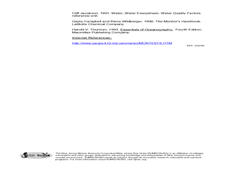Curated OER
Mouse...Mouse...Snake!
Use this activity as an anticipatory set to warm up for a lesson on predator/prey relationships. Pupils will play a round of "Duck, Duck, Goose," substituting the ducks and geese for two animals that have a predator/prey relationship....
Curated OER
Food Chains and Food Webs
Fourth graders study intertidal organisms and their role in the food web. In this food web lesson, 4th graders read the book The Sea That Feeds Us and discuss food webs. Students study pictures of intertidal creatures and discuss their...
Curated OER
Introduction to Sea Horses
Students identify different types of sea horses. In this sea horse research lesson, students learn associated vocabulary and listen as the teacher reads Elaine Landau's, Sea Horses A True Book. They visit assigned Internet sites to find...
Curated OER
Phytoplankton and Ocean Color
Fifth graders identify function of phytoplankton in the biospere by conducting experiments and simulations and reading for information. They detect the presence of phytoplankton in bodies of water by examining ocean in satellite images...
Curated OER
Bermuda Reef Diorama
Students build a Bermuda coral reef to gain a better understanding of this ecosystem.
Curated OER
Life Means Water Environment
Students investigate pH levels in bodies of water and experiment with acid/base reactions. In this water and pH lesson, students observe changes in pH levels of a sample solution and observe a Bronsted-Lowry reaction. Students...
Curated OER
Captivating Clownfish Quiz
In this online quiz worksheet, students answer a set of multiple choice questions about clownfish. Page includes links to answers and resources.
Curated OER
Just Jelly
Students identify common gelatinous zooplankton in the Canada Basin and their ecological role. They compare and contrast feeding strategies of at least three different types of gelatinous zooplankton.
Curated OER
Save the Bay
Students explore the concept of environmental stewardship. In this science lesson, students examine the environmental effects of oil spills as they replicate a contained oil spill and clean up.
Curated OER
Aquatic Ecosystems
Ninth graders record information on aquatic ecosystems and create a labeled diagram of an ecosystem of their choice. They can choose from an ocean zone, estuary, river, lakes, or beaches. The student has to explain their biome of choice.
Curated OER
A Healthy Environment
Students market healthy environments. In this healthy environment lesson, students participate in an activity that requires them to examine the food web. Students then research healthy and unhealthy environments and use their findings to...
Curated OER
Giant Jellyfish Invasion
In this reading comprehension skills activity, students read a 1 page selection entitled "Giant Jellyfish Invasion" and then respond to 5 multiple choice questions.
Curated OER
Living With the Heat: The Ring of Fire
Students investigate the planet Earth's infamous ring of fire and the life that thrives from it. In this ocean environment lesson plan, students investigate hydrothermal vents and how organisms thrive off their heat. Students...
Curated OER
The Web of Life
Students participate in a game in which they discover the balance of life in the ocean. They identify different organisms that rely on different types of food. They answer questions to complete the instructional activity.
Curated OER
Whale Fast Food Conversions
Students calculate feeding rates of whales and compare this to the feeding rates of humans.
Curated OER
Whales
Students compare and contrast the two types of whales. In this biology lesson, students research the characteristics of their assigned whale. They compile their findings in a folder.
Curated OER
Water Quality Monitoring
Students comprehend the four parameters of water quality. They perform tests for salinity, dissolved oxygen, pH and clarity or turbidity. Students comprehend why scientists and environmental managers monitor water uality and aquatic...
Curated OER
Density Stratification and Ocean Circulation
Students examine how circulation currents of the ocean. They use a tub of hot and cold water to demonstrate the currents. They discover how salinity and temperature of water affect its movement.
Curated OER
C.S.I. on the Deep Reef
Students study chemotropic sybioses and chemotropic nutrition. In groups, they complete a Chemotrophic Species Investigations (CSI) Worksheet.






